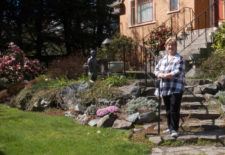Actively Transporting
CENTRAL SAANICH COMMUNITY LOOKS AT HOW TO MAKE ROADS SAFER
by Sue Stroud, citizen reporter
The Central Saanich Community Association (CSCA) has recently formed an Active Transportation Task Force to address road safety issues that they say have become a concern for many in the community. The task force is currently developing a series of actions that it plans to propose to the District of Central Saanich Council as well as preparing for the Central Saanich Official Community Plan (OCP) review in 2019.
The Task Force is being guided by a road safety improvement ethic called Vision Zero. The revolutionary Swedish plan proposes that no deaths or serious injuries on the road are acceptable and asks that all road planning start there.
The term “active transportation” includes walking, running, cycling, horseback riding, rollerblading, skateboarding, and the use of mobility devices such as motorized scooters, walkers etc. And while road safety planning looks at methods and measures for reducing the risks of injury or death of all persons using the road network, the newly-formed Central Saanich task force will specifically focus on the safety of its active transportation road users as they are the most vulnerable to serious injury and death.
The active transportation networks that the Task Force will focus on is more than just roads, sidewalks and crosswalks. The network also includes bus stops, park and rides, scooter parking, on-road bicycle lanes, protected or separated bike lanes, off-road hiking or bicycle trails, bridle paths, multi-use pathways, and bike parking facilities.
Historically road planning has tried to balance travel efficiency and convenience with safety – often with a priority given to efficiency and leaving a certain amount of injury and even death thought to be inevitable and as such acceptable. Obviously the safest roads would see no one in a vehicle that’s moving faster than a body could withstand an impact from – but there’s little that’s efficient or convenient about that for the commuter, business, or travellers. So compromise begins there.
Vision Zero has been adopted by many other jurisdictions around the world – including the province of BC. Such a plan would include explicit goals and measurable strategies with clear time-lines, and identify the responsible stakeholders. The plan would be built into the Central Saanich OCP and budget. It would focus on the ability of all local students to safely travel using Active Transportation methods to their designated schools, activities and homes, and would also facilitate residents within the three main urban communities: Keating/Tanner Ridge, Saanichton and Brentwood Bay to have the ability to use Active Transportation methods to safely travel between each of these centres.
Since Vision Zero was started in 1997, it has been adopted by a growing number of communities in North America. While safe mobility is not a new concept, Vision Zero requires a shift in how communities approach decisions, actions, and attitudes around safe mobility. Instead of treating road safety as a one-by-one trouble zone issue, it tackles road safety as a system. By changing the planning and thinking around road safety any municipality or district will ultimately be saving money at the individual, community, healthcare and societal levels. Not to mention lives.
The general input received by the Active Transportation Task Force of the CSCA is concern around how unsafe active transportation is within Central Saanich. And while there are areas with good active transportation options it was thought to be most safe to travel to these areas by car.
Bruce Elliot, of CSCA’s Active Transportation Task Force says,
“The common message we’re hearing is that Active Transportation activities are avoided by Central Saanich residents because they just don’t feel safe.”
Elliot cited increasing commuter traffic cutting through the District in greater numbers and at greater speed than in the past; a lack of sidewalks, crosswalks, protected bike lanes, wide marked shoulders and equestrian bridle paths connecting villages are of concern; as is a lack of separation of cars, trucks and buses from those participating in Active Transportation – and poor street lighting all inhibit the community embracing a lifestyle that includes Active Transportation.
“We can do better,” says Elliot.
Because of the relatively small population size and tax base Central Saanich has to be creative when funding this infrastructure but the Task Force is not without suggested solutions. They propose that some funds from the parks acquisition fund be used to purchase rights of way for off-road paths and trails and that various provincial health and wellness grants be tapped for funding as well. They are also recommending that the District reach out to ICBC, BC Ferries, the Ministry of Transportation, School District 63 and local First Nations Tsartlip and Tsawout to identify partnership opportunities for road safety and active transportation infrastructure. The task force further hopes that Active Transportation will be listed as a separate line item within the annual budget.
LINKS:
The Central Saanich Community Association can be reached via email at [email protected] and can be followed on Facebook. More on Vision Zero. Sweden has now moved to Beyond Vision Zero to an approach specifically targeting Active Transportation road safety.


